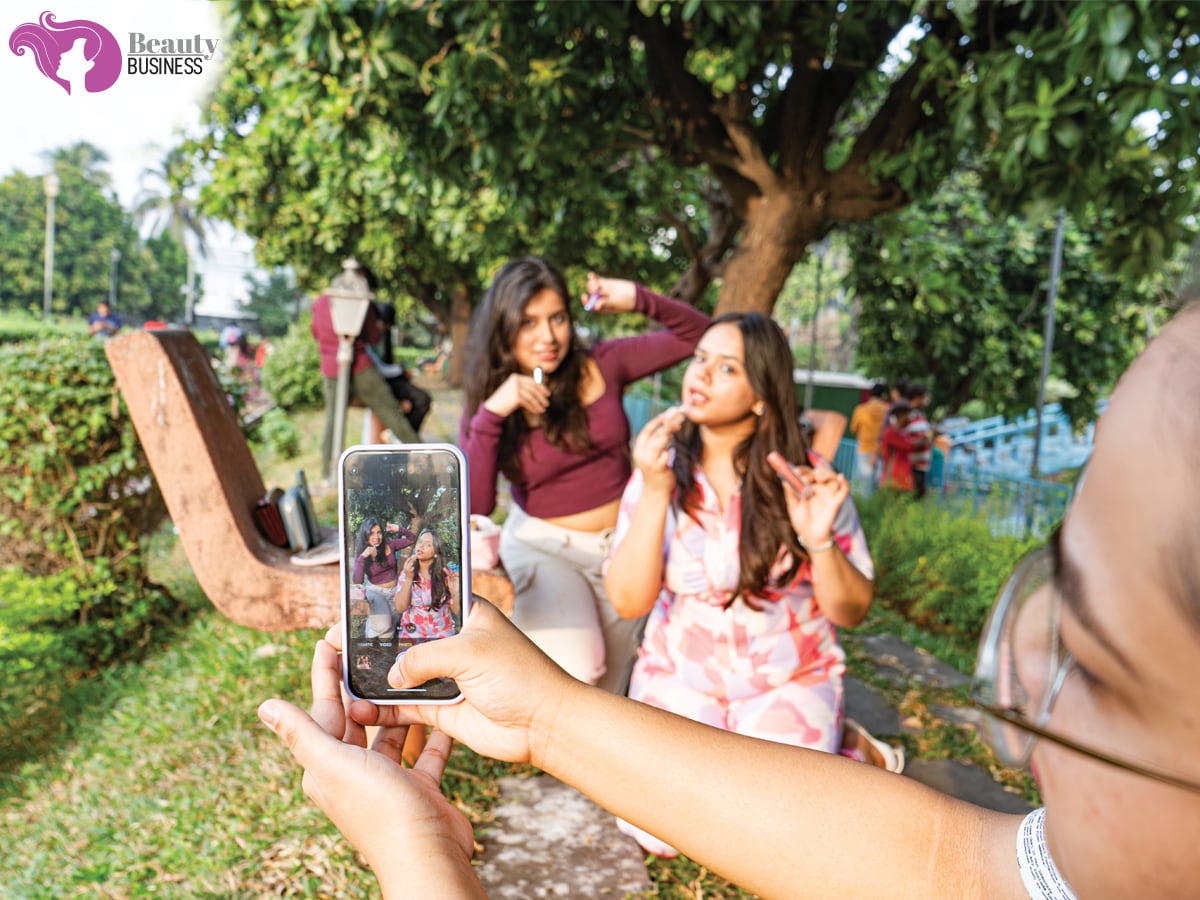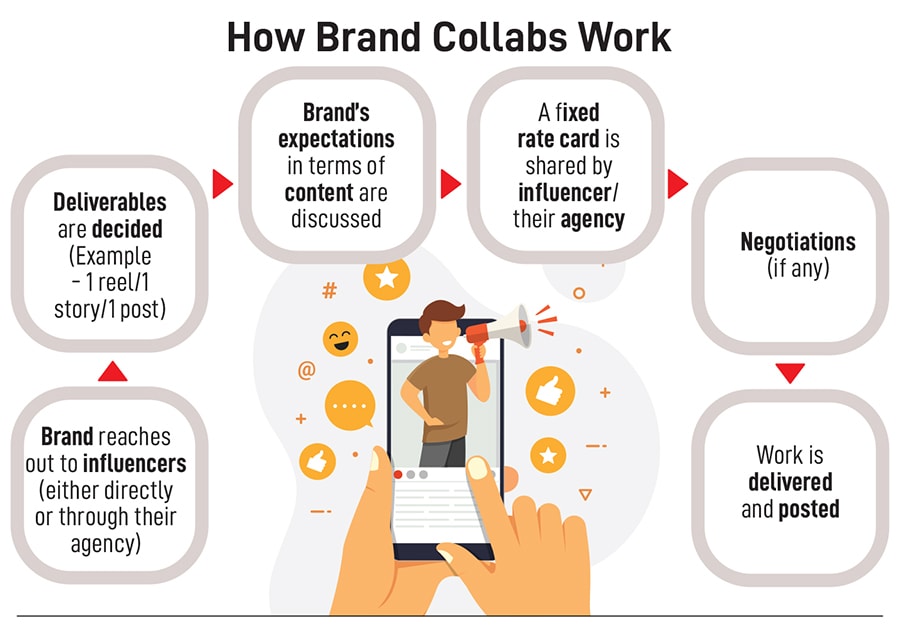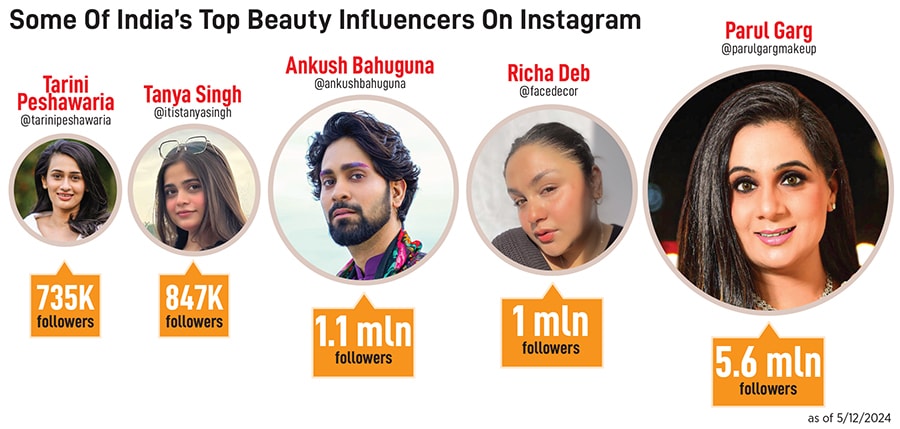 From (L to R): Sanya Jain and Aakarshika Pandey creating beauty content for their Instagram feeds at Jogger’s Park in Bandra, Mumbai. Image: Neha Mithbawkar for Forbes India
From (L to R): Sanya Jain and Aakarshika Pandey creating beauty content for their Instagram feeds at Jogger’s Park in Bandra, Mumbai. Image: Neha Mithbawkar for Forbes India
Like many of us, Aakarshika Pandey, reaches for her phone the moment she wakes up, and starts scrolling through Instagram. Having just moved to Mumbai for college, the 19-year-old often engages with the content of a bunch of beauty influencers who post get-ready-with-me (GRWM) videos, makeup tutorials, product review videos, and such like.
Pandey’s engagement with these influencers is not limited to watching their content, but extends to buying some of the products they recommend. “I have purchased too many products that I saw on Instagram Reels. I usually buy products suggested by Richa Deb, who recommends nice and affordable products,” says Pandey.
In the past few years, the beauty industry in India has experienced remarkable growth, generating billions of dollars through product sales, influencer collaborations, and targeted marketing campaigns. A major catalyst for this is the widespread influence of social media platforms such as Instagram and YouTube, which have fundamentally reshaped the way beauty products are marketed and used. Earlier, when most people relied on television commercials, recommendations by beauty parlours or feedback from friends on makeup and skincare products, the baton today has been passed to influencers. The rise of short-form videos especially curated around beauty, including GRWM videos, morning/night skincare routines, product reviews, unboxing, and many more, has cultivated an environment where trends can gain immense traction within hours, making consumers not only more informed but also significantly more susceptible to social influence.
Central to this shift is the democratisation of beauty knowledge. Traditionally, beauty trends were shaped by industry gatekeepers, including high-end fashion magazines, established brands, and celebrity endorsements. However, the emergence of social media has disrupted this model, providing a platform where individuals—from professional makeup artistes to everyday enthusiasts—can assume the role of trendsetters. With millions of users posting tutorials, product reviews, and before-and-after transformations, beauty trends now spread rapidly, often propelled by consumers rather than conventional advertising channels.
A recent report by Nykaa, in collaboration with consulting firm Redseer, projects that the Indian beauty and personal care market will grow to $34 billion by 2028, up from its current value of $21 billion. This growth is primarily fuelled by increased online penetration and a rising demand for high-quality, premium beauty products.
Also read: EXCLUSIVE: How William Lauder built Estée Lauder Companies into a global beauty giant
Beauty is, without any doubt, an emerging category on social media, and the country is seeing more and more people joining the bandwagon of becoming influencers. Some of the most popular ones in India include Parul Garg, Ankush Bahuguna, Mrunal Panchal, and Tarini Peshawaria, who post content almost on a daily basis.
Amidst these popular influencers, there exists the up-and-coming ones who have taken inspiration from beauty creators, both in India and abroad. They are working to create their own niche, gain followers, and participate in brand collaboration, monetising their endeavour.
One such is Parnika Tomar. Growing up, Tomar always had an affinity towards skincare and beauty products, and after completing her graduation, she chanced upon becoming a beauty influencer, after one of her posts on Instagram went viral. “I always found comfort in skincare and makeup. I had a major acne breakout in college, and that’s when I got more involved in understanding how my confidence was related to it,” says the 25-year-old based in Mumbai. Tomar, who has 138,000 followers on Instagram, grew up watching videos by Blair Fowler, a YouTuber who has been making makeup tutorial videos for years. “It was just embedded in my head,” says Tomar, who started making beauty content on Instagram in 2022.

While creatively she didn’t face many challenges initially, a few hiccups did arise when it came to monetising. “I didn’t have any mentors to guide me through it. This is a field where you don’t have a blueprint to follow,” she says. Tomar has collaborated with brands such as Sephora India, L’Oréal Paris, Maybelline, and Pond’s. While most brands maintain a smooth process of payment, there are few who tend to delay, leaving influencers following up for months.
Money eventually comes, but what’s really important for these influencers is the leeway they get to maintain their authenticity in brand videos. “I like to work with brands that let me be myself and are fine with the authenticity that my work reflects,” says Tomar, highlighting that a lot of brands bully influencers to do just advertising. “I realised the more authentic you are, the more you have to offer a brand that nobody else can, so it becomes less likely for any brand to be able to exploit you. You also need a lot of patience.”

Shantanu Dhope agrees with Tomar. He believes that to be a successful beauty influencer today one also needs to be consistent. Dhope grew up doing the makeup for his mother and sister when they would go out for functions and developed a knack for it. After finishing his diploma in civil engineering, he decided to go to Fat Mu Makeup Institute in Mumbai’s Bandra. He’s been a makeup artiste for the past 10 years, and started making content only four years ago.
The 28-year-old is among the few men in this female-dominated industry, and his content includes a lot of Reels where he tries out different products, reviews them, and videos where he tries out products with his mother. When Dhope was starting out, making beauty content was a little challenging for him. “I do not have any experience in terms of filming. I just figured it out from watching other people, and watching YouTube tutorials,” says Dhope, whose inspiration has always been Nikkie de Jagger, a Dutch Instagram makeup creator.

Dhope, who has 60,000 followers, has worked with brands such as Estee Lauder, NYX Cosmetics and Maybelline. While deciding on collaborations, his relationship with the brand is a big priority for him. The second is if he already uses their products, or aligns with the brand’s ideologies. “If there is a product that brands want me to use for a video, then I would test it out for a couple of weeks before I make a video on it, and if it works well for me, only then I will do it,” says Dhope.
Influencer boom = industry boom?
Mohit Yadav, co-founder of Minimalist, one of the fastest growing consumer products brands in the country, believes there exists a direct relationship between the growth of the beauty industry in India and the rise of beauty influencers on social media. He believes the contribution of platforms like Instagram and YouTube to India’s beauty industry cannot be overstated. “Instagram Reels, in particular, have revolutionised how beauty is marketed—by creating bite-sized, visually impactful content that resonates instantly. Reels have turned skincare into a mainstream conversation,” says Yadav. For Minimalist, he adds, Reels are a tool for customer awareness, allowing the brand to simplify complex skincare topics into digestible, engaging visuals. Not limited to influencers, Yadav feels that customer-created Reels further add to the growth of the brand.
He believes the rise of influencers has democratised access to skincare knowledge, made beauty more inclusive, and has given a voice to diverse creators who challenge conventional beauty norms and bring forth conversations around ingredients, routines, and individual skin journeys. “This surge of authentic and relatable content has empowered consumers to make informed choices, directly contributing to the explosive growth of India’s beauty industry,” he adds.
Also read: India’s beauty industry far from skin deep. What’s driving the $34 billion ambition?
Tomar and Dhope share similar views. Tomar makes an important point by highlighting that the rise of beauty influencers led to communication around the gap in the Indian market a few years ago. “It’s because of social media that global brands and even homegrown brands were able to pay attention to such an untapped market. Homegrown beauty companies levelled up and we have so many global companies joining in,” says Tomar. Dhope believes that while India has always had a big beauty market in general, but maybe not as much on social media till now. “I think the rise in creators has led to the rise in consumers, which has eventually led to the growth in the country’s beauty industry,” adds Dhope.
Sanya Jain, a 20-year-old student from Mumbai, is the perfect example of an increase in consumers ever since the rise of influencers. Jain loves to watch makeup and skincare videos on Instagram where the creators give their unfiltered takes on products. “Since I have a few skin issues I look forward to videos from creators who address those issues,” says Jain. With influencers such as Tarini Peshawaria, Prakriti Singh, Ankush Bahuguna and Mrunal Panchal on her ‘following list’, Jain looks forward to realistic and simple makeup and skincare routines and also quirky and fun beauty-related content. When it comes to buying products, recommendations by these influencers are her go-to. “I buy most of my new makeup products after watching my favourite creators try it. Recently Korean skincare is all over the internet, hence I bought some of those products as well. I can say Instagram made me buy it, to get the viral Korean glass skin,” adds Jain.
There is a growth in the industry, without a doubt, but that growth comes with a few concerns as well. Tomar believes that so much growth can also lead to consumerism—sometimes, people don’t need certain things, and are forced to buy it due to an overdose of content or peer pressure. Brands bank upon this and are willing to provide consumers with products on low EMIs. Tomar believes this is harmful. Another thing she hopes doesn’t happen is for the market to tell consumers that they need a product because it is a gamechanger. “When brands make it a point to make someone feel like they’re lacking something in their life, that’s just bad. I hope we don’t ever normalise it,” adds Tomar.
Rise of homegrown brands
While Indian consumers have for long relied on global brands like Maybelline, MAC, and L’Oréal Paris, a growing number of homegrown makeup brands have emerged in recent years. Brands such as MyGlamm, Sugar, Mamaearth, Plum, Minimalist, Nykaa Cosmetics, and Just Herbs have effectively utilised digital platforms to establish strong connections with consumers and address a wide range of beauty needs. These brands have particularly resonated with millennial and Gen Z shoppers, who favour online shopping, personalised marketing, and products that embrace diverse beauty standards. They offer high-quality, innovative products that align with modern preferences for natural ingredients, sustainability, and inclusivity. By prioritising ecommerce, social media engagement, and influencer marketing, these brands have cultivated loyal customer communities and set new trends.
A bunch of celebrities in India have also started their own makeup brands. A few examples include Kay Beauty by Katrina Kaif, LoveChild by Masaba Gupta, Akind by Mira Kapoor, Hyphen by Kriti Sanon, and 82°E by Deepika Padukone. The founders not only use influencers to promote their products, but most of them have taken on the role of creators themselves, and often post videos of trying out their own products, reviewing them, and making GRWM videos using them. This often leads to their fans buying these products. “I also often buy products from celebrity-owned brands. Not just Indian celebrities, but also brands owned by Selena Gomez and Hailey Bieber,” says Jain.
The rise and rise of beauty influencers
 Both Tomar and Dhope are of the view that, earlier, the beauty and skincare niche was very small; now that’s changed. Not just has the number of creators gone up, but even the kind of content they create has evolved. Initially, most creators were just following the popular ones and making content similar to something that was already out there. But lately creators are bringing their own style and perspectives to the content.
Both Tomar and Dhope are of the view that, earlier, the beauty and skincare niche was very small; now that’s changed. Not just has the number of creators gone up, but even the kind of content they create has evolved. Initially, most creators were just following the popular ones and making content similar to something that was already out there. But lately creators are bringing their own style and perspectives to the content.
However, there have been some negatives to the boom too. According to Tomar, the audience’s engagement with creators is falling and they only care about the ultimate product, which is the URL to buy it from. “Lately, I have started feeling like a search engine where nobody cares about what content I am putting out. All they want is the link to the product. The sense of community is going down. People just want to get to the point. I’ve seen in two years how my audience and I engaged, especially with the new audience,” says Tomar. Regardless, she wishes to continue her work as a beauty creator for a long time, and hopes that the growth is in the right direction. “Earlier, the entire beauty industry’s foundation was to feed on people’s insecurities, and now it’s gradually moving towards empowering them. I hope that’s what it is used for in the future as well.”
